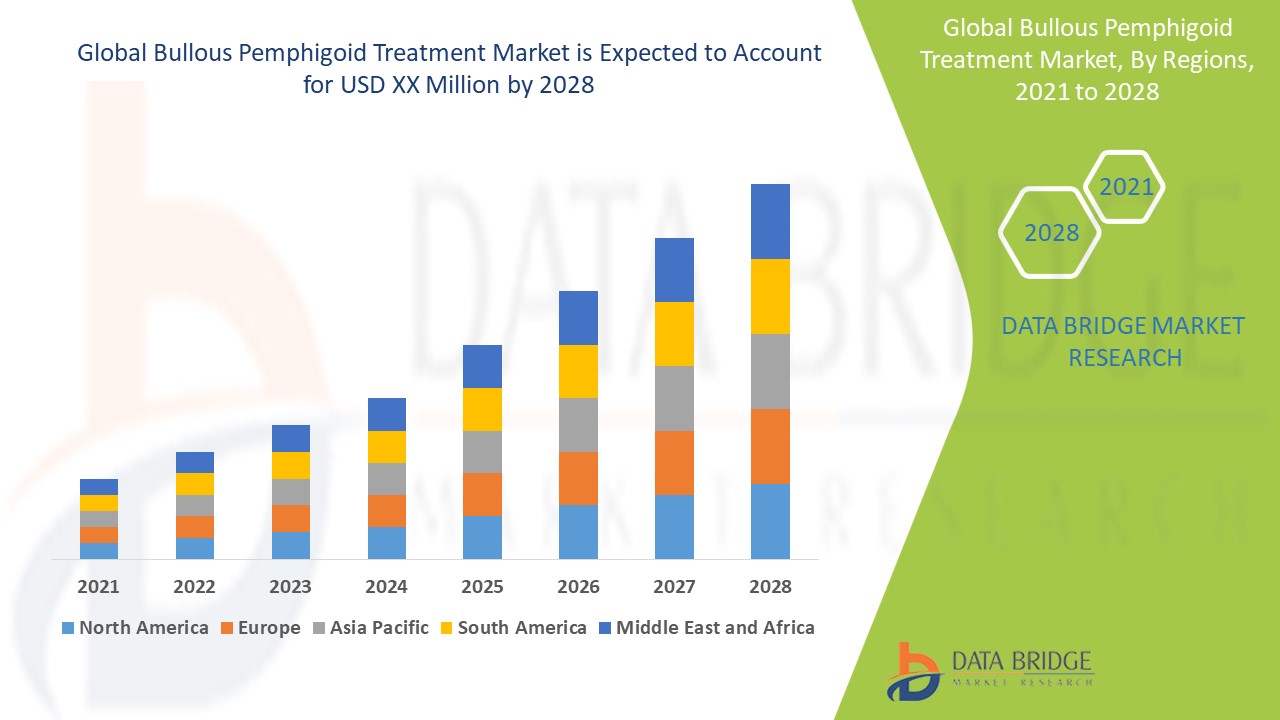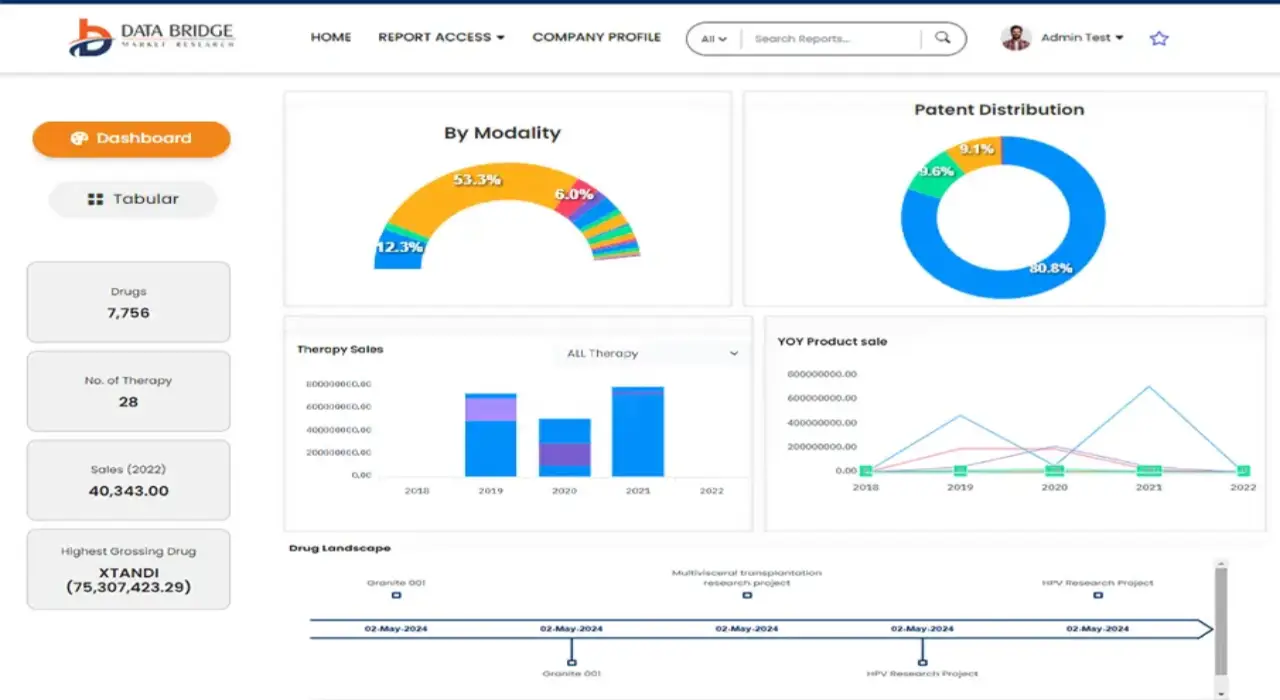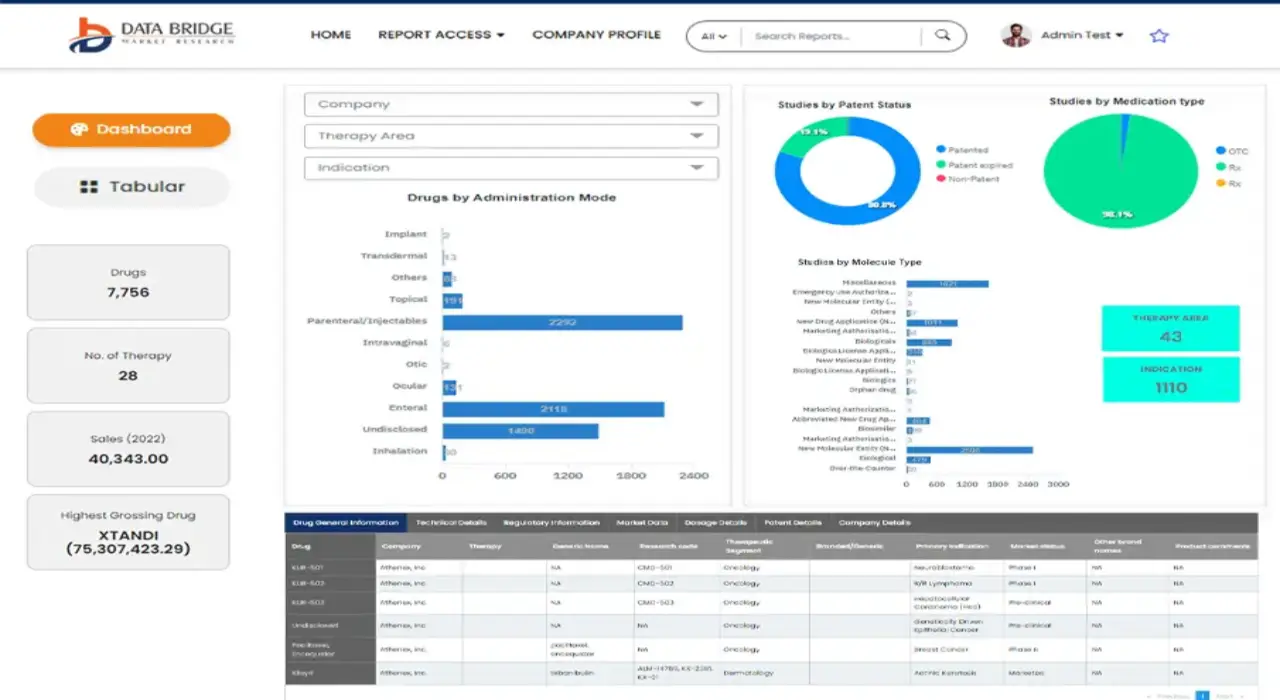Global Bullous Pemphigoid Treatment Market
Market Size in USD Billion
CAGR :
% 
 USD
1.93 Billion
USD
2.76 Billion
2024
2032
USD
1.93 Billion
USD
2.76 Billion
2024
2032
| 2025 –2032 | |
| USD 1.93 Billion | |
| USD 2.76 Billion | |
|
|
|
|
Global Bullous Pemphigoid Treatment Market Segmentation, By Treatment (Immunosuppressant Medication, Steroids, Antibiotics & Antiseptics, and Pain Relief Medication), Route of Administration (Topical, Injectable, and Oral), Diagnosis (Skin Biopsy, Physical Examination, and Blood Test), End-Users (Clinic, Hospital, and Others), Distribution Channel (Hospital Pharmacy, Retail Pharmacy, and Online Pharmacy) – Industry Trends and Forecast to 2032
Bullous Pemphigoid Treatment Market Analysis
The bullous pemphigoid treatment market is driven by increasing awareness and advancements in therapeutic options for managing this rare autoimmune blistering disorder. Bullous pemphigoid primarily affects older adults, causing painful blisters and skin lesions, and requires targeted treatment for symptom control. The market has seen a shift towards biologics, immunosuppressive agents, and corticosteroids as the primary treatments. Key players are focusing on developing innovative therapies to improve patient outcomes and reduce side effects. Recent developments include the approval of monoclonal antibodies such as rituximab, which target specific immune pathways to reduce flare-ups. Increased research into targeted therapies, coupled with a growing geriatric population, is expected to further boost market growth. In addition, the adoption of combination therapies and new drug formulations are contributing to market expansion. Ongoing clinical trials and a deeper understanding of the disease pathophysiology are likely to bring forth novel treatments, enhancing the bullous pemphigoid treatment landscape.
Bullous Pemphigoid Treatment Market Size
The global bullous pemphigoid treatment market size was valued at USD 1.93 billion in 2024 and is projected to reach USD 2.76 billion by 2032, with a CAGR of 4.60% during the forecast period of 2025 to 2032. In addition to the insights on market scenarios such as market value, growth rate, segmentation, geographical coverage, and major players, the market reports curated by the Data Bridge Market Research also include depth expert analysis, patient epidemiology, pipeline analysis, pricing analysis, and regulatory framework.
Bullous Pemphigoid Treatment Market Trends
“Shift Toward Biologic Therapies”
The bullous pemphigoid treatment market is evolving with significant advancements in therapy options, driven by the growing need for effective treatments for this rare autoimmune disorder. One of the key trends in the market is the increasing shift toward biologic therapies, particularly monoclonal antibodies such as rituximab, which offer targeted treatment with fewer side effects compared to traditional corticosteroids. Innovations in drug formulations and combination therapies are also gaining traction, enhancing treatment efficacy and patient outcomes. As the disease primarily affects the elderly, the market is expected to grow with rising awareness and better diagnostic tools. Ongoing research into the disease's pathophysiology continues to fuel innovation, leading to more effective and personalized treatment options in the bullous pemphigoid landscape.
Report Scope and Bullous Pemphigoid Treatment Market Segmentation
|
Attributes |
Bullous Pemphigoid Treatment Key Market Insights |
|
Segments Covered |
|
|
Countries Covered |
U.S., Canada and Mexico in North America, Germany, France, U.K., Netherlands, Switzerland, Belgium, Russia, Italy, Spain, Turkey, Rest of Europe in Europe, China, Japan, India, South Korea, Singapore, Malaysia, Australia, Thailand, Indonesia, Philippines, Rest of Asia-Pacific (APAC) in the Asia-Pacific (APAC), Saudi Arabia, U.A.E., South Africa, Egypt, Israel, Rest of Middle East and Africa (MEA) as a part of Middle East and Africa (MEA), Brazil, Argentina and Rest of South America as part of South America. |
|
Key Market Players |
Almirall, S.A (Spain), Pfizer Inc. (U.S.), F. Hoffmann-La Roche Ltd (Switzerland), SiriusLabs (U.S.), Teva Pharmaceutical Industries Ltd (Israel), Astellas Pharma Inc. (Japan), Aegis Lifesciences Pvt. Ltd (India), Sun Pharmaceutical Industries Ltd (India), Zydus Group (U.S.), Novartis AG (Switzerland), Viatris Inc. (U.S.), Baxter (U.S.), Bayer AG (Germany), Omega Laboratories, Inc. (U.S.), Merck KGaA (Germany) |
|
Market Opportunities |
|
|
Value Added Data Infosets |
In addition to the insights on market scenarios such as market value, growth rate, segmentation, geographical coverage, and major players, the market reports curated by the Data Bridge Market Research also include depth expert analysis, patient epidemiology, pipeline analysis, pricing analysis, and regulatory framework. |
Bullous Pemphigoid Treatment Market Definition
Bullous pemphigoid treatment refers to the medical management of bullous pemphigoid, a rare autoimmune disorder that causes large, fluid-filled blisters on the skin. The treatment focuses on controlling symptoms, reducing inflammation, and preventing new blisters. Common therapies include corticosteroids to manage inflammation, immunosuppressive agents such as azathioprine, and biologic therapies such as rituximab. These treatments aim to suppress the immune system's abnormal response, which causes the skin blistering, and improve the quality of life for patients. In more severe cases, treatments may be combined to achieve better disease control. The goal of bullous pemphigoid treatment is to reduce flare-ups, manage symptoms, and prevent complications such as infection.
Bullous Pemphigoid Treatment Market Dynamics
Drivers
- Rising Healthcare Expenditure
Growing healthcare investments, particularly in the treatment of rare diseases such as bullous pemphigoid, are significantly driving the market for advanced treatment options. As governments and private organizations allocate more resources to healthcare, there is an increased focus on addressing unmet needs in rare disease management. This investment accelerates the development of innovative therapies, such as biologics and targeted treatments, and facilitates greater access to these treatments for patients. The expansion of healthcare budgets and funding for research into rare diseases is fostering an environment conducive to the growth of the bullous pemphigoid treatment market.
- Improved Diagnosis and Awareness
Increased awareness and improvements in diagnostic techniques are key drivers of the bullous pemphigoid treatment market. As awareness of the disease grows among healthcare professionals and the general public, earlier detection has become more common, allowing for timely intervention. Advanced diagnostic methods, including skin biopsies and blood tests, enable more accurate diagnosis, facilitating the implementation of targeted treatments that improve patient outcomes. This early identification of the disease reduces the risk of complications and leads to more effective management of symptoms. Consequently, these advancements in diagnosis and awareness are boosting the demand for treatment options, propelling market growth.
Opportunities
- Advancements in Personalized Medicine
The growing focus on personalized medicine presents a significant opportunity in the bullous pemphigoid treatment market. Personalized medicine involves tailoring treatments to individual patient profiles based on factors such as genetics, disease severity, and response to previous therapies. This approach enhances treatment efficacy and reduces side effects, offering patients more customized and targeted care. In the context of bullous pemphigoid, personalized therapies could lead to better management of the disease, especially in complex cases. As research into genetic biomarkers and individualized treatment plans advances, it is expected to drive innovation and market growth, creating new opportunities for effective management of this rare disease.
- Increasing Aging Population
The global rise in the elderly population presents a significant market opportunity for the bullous pemphigoid treatment sector. As the incidence of age-related diseases, including bullous pemphigoid, increases with aging populations, the demand for effective treatment solutions is expected to grow. Older adults are more susceptible to autoimmune disorders, and early detection and tailored therapies for managing symptoms are becoming essential. This demographic shift creates a steady demand for treatment and drives innovation in drug development and therapeutic approaches aimed at improving the quality of life for elderly patients. Consequently, the aging population represents a key growth driver for the bullous pemphigoid treatment market.
Restraints/Challenges
- Limited Treatment Options
Despite advancements in the bullous pemphigoid treatment landscape, effective therapies remain limited, presenting a significant market challenge. Current treatment options, including corticosteroids and immunosuppressive drugs, are effective in controlling the disease but come with notable side effects such as weight gain, osteoporosis, and an increased risk of infections. These side effects can impact patient compliance and quality of life. As a result, there is a pressing need for better, more targeted treatment options that can provide effective disease control while minimizing adverse effects. This gap in treatment options highlights the challenge of finding more sustainable and safer therapies for bullous pemphigoid.
- High Treatment Costs
The high cost of advanced treatments, particularly biologics and immunosuppressive therapies, presents a significant restraint in the bullous pemphigoid treatment market. These therapies, while effective, can be prohibitively expensive, creating financial barriers for both healthcare providers and patients. In regions with limited healthcare budgets or inadequate insurance coverage, the cost of treatment can become a major obstacle to access, limiting the adoption of newer and more effective therapies. This challenge may lead to delayed treatment or reliance on less effective, more affordable options, which can affect patient outcomes and hinder overall market growth.
This market report provides details of new recent developments, trade regulations, import-export analysis, production analysis, value chain optimization, market share, impact of domestic and localized market players, analyses opportunities in terms of emerging revenue pockets, changes in market regulations, strategic market growth analysis, market size, category market growths, application niches and dominance, product approvals, product launches, geographic expansions, technological innovations in the market. To gain more info on the market contact Data Bridge Market Research for an Analyst Brief, our team will help you take an informed market decision to achieve market growth.
Bullous Pemphigoid Treatment Market Scope
The market is segmented on the basis of treatment, route of administration, diagnosis, end-user, and distribution channel. The growth amongst these segments will help you analyse meagre growth segments in the industries and provide the users with a valuable market overview and market insights to help them make strategic decisions for identifying core market applications.
Treatment
- Immunosuppressant Medication
- Steroids
- Antibiotics & Antiseptics
- Pain Relief Medication
Route of Administration:
- Topical
- Injectable
- Oral
Diagnosis
- Skin Biopsy
- Physical Examination
- Blood Test
End-Users
- Clinic
- Hospital
- Others
Distribution Channel
- Hospital Pharmacy
- Retail Pharmacy
- Online Pharmacy
Bullous Pemphigoid Treatment Market Regional Analysis
The market is analysed and market size insights and trends are provided by country, treatment, route of administration, diagnosis, end-user, and distribution channel as referenced above.
The countries covered in the market report are U.S., Canada and Mexico in North America, Germany, France, U.K., Netherlands, Switzerland, Belgium, Russia, Italy, Spain, Turkey, Rest of Europe in Europe, China, Japan, India, South Korea, Singapore, Malaysia, Australia, Thailand, Indonesia, Philippines, Rest of Asia-Pacific (APAC) in the Asia-Pacific (APAC), Saudi Arabia, U.A.E., South Africa, Egypt, Israel, Rest of Middle East and Africa (MEA) as a part of Middle East and Africa (MEA), Brazil, Argentina and Rest of South America as part of South America.
North America dominates the bullous pemphigoid treatment market, driven by the presence of major industry players and ongoing technological advancements. The region benefits from a well-established healthcare infrastructure, which supports the rapid adoption of innovative treatments. In addition, rising health awareness and strong healthcare policies contribute to the growing demand for effective bullous pemphigoid therapies in North America.
Europe is projected to experience growth during the forecast period, fueled by increased research and development activities and rising investments in the healthcare sector. The region’s economic growth, coupled with advancements in medical technology, further enhances the market potential. In addition, the growing patient population in Europe is expected to drive the demand for effective bullous pemphigoid treatments, supporting market expansion.
The country section of the report also provides individual market impacting factors and changes in regulation in the market domestically that impacts the current and future trends of the market. Data points such as down-stream and upstream value chain analysis, technical trends and porter's five forces analysis, case studies are some of the pointers used to forecast the market scenario for individual countries. Also, the presence and availability of global brands and their challenges faced due to large or scarce competition from local and domestic brands, impact of domestic tariffs and trade routes are considered while providing forecast analysis of the country data.
Bullous Pemphigoid Treatment Market Share
The market competitive landscape provides details by competitor. Details included are company overview, company financials, revenue generated, market potential, investment in research and development, new market initiatives, global presence, production sites and facilities, production capacities, company strengths and weaknesses, product launch, product width and breadth, application dominance. The above data points provided are only related to the companies' focus related to market.
Bullous Pemphigoid Treatment Market Leaders Operating in the Market Are:
- Almirall, S.A (Spain)
- Pfizer Inc. (U.S.)
- F. Hoffmann-La Roche Ltd (Switzerland)
- SiriusLabs (U.S.)
- Teva Pharmaceutical Industries Ltd (Israel)
- Astellas Pharma Inc. (Japan)
- Aegis Lifesciences Pvt. Ltd (India)
- Sun Pharmaceutical Industries Ltd (India)
- Zydus Group (U.S.)
- Novartis AG (Switzerland)
- Viatris Inc. (U.S.)
- Baxter (U.S.)
- Bayer AG (Germany)
- Omega Laboratories, Inc. (U.S.)
- Merck KGaA (Germany)
Latest Developments in Bullous Pemphigoid Treatment Market
- In February 2024, Nuvig Therapeutics, Inc. announced the administration of the first human dose of NVG-2089, a patented drug under development for treating inflammatory myopathies and severe dermatologic autoimmune diseases. The company also revealed that the FDA granted Fast Track Designation (FTD) to NVG-2089 for its development in treating bullous pemphigoid. This milestone accelerates the drug's pathway toward potential approval, highlighting its promise in addressing this rare autoimmune disorder
- In December 2023, Argenx SE announced the topline results of the ADDRESS trial, which assessed efgartigimod subcutaneous (SC) (efgartigimod alfa and hyaluronidase-qvfc) in adults with pemphigus vulgaris (PV) and pemphigus foliaceus (PF). The results showed no significant difference between efgartigimod SC and placebo in the proportion of PV patients achieving the primary endpoint of complete remission on a minimal steroid dose (CRmin). These findings suggest that efgartigimod SC may not provide superior efficacy compared to the placebo in achieving CRmin in PV patients
SKU-
Get online access to the report on the World's First Market Intelligence Cloud
- Interactive Data Analysis Dashboard
- Company Analysis Dashboard for high growth potential opportunities
- Research Analyst Access for customization & queries
- Competitor Analysis with Interactive dashboard
- Latest News, Updates & Trend analysis
- Harness the Power of Benchmark Analysis for Comprehensive Competitor Tracking
Research Methodology
Data collection and base year analysis are done using data collection modules with large sample sizes. The stage includes obtaining market information or related data through various sources and strategies. It includes examining and planning all the data acquired from the past in advance. It likewise envelops the examination of information inconsistencies seen across different information sources. The market data is analysed and estimated using market statistical and coherent models. Also, market share analysis and key trend analysis are the major success factors in the market report. To know more, please request an analyst call or drop down your inquiry.
The key research methodology used by DBMR research team is data triangulation which involves data mining, analysis of the impact of data variables on the market and primary (industry expert) validation. Data models include Vendor Positioning Grid, Market Time Line Analysis, Market Overview and Guide, Company Positioning Grid, Patent Analysis, Pricing Analysis, Company Market Share Analysis, Standards of Measurement, Global versus Regional and Vendor Share Analysis. To know more about the research methodology, drop in an inquiry to speak to our industry experts.
Customization Available
Data Bridge Market Research is a leader in advanced formative research. We take pride in servicing our existing and new customers with data and analysis that match and suits their goal. The report can be customized to include price trend analysis of target brands understanding the market for additional countries (ask for the list of countries), clinical trial results data, literature review, refurbished market and product base analysis. Market analysis of target competitors can be analyzed from technology-based analysis to market portfolio strategies. We can add as many competitors that you require data about in the format and data style you are looking for. Our team of analysts can also provide you data in crude raw excel files pivot tables (Fact book) or can assist you in creating presentations from the data sets available in the report.













